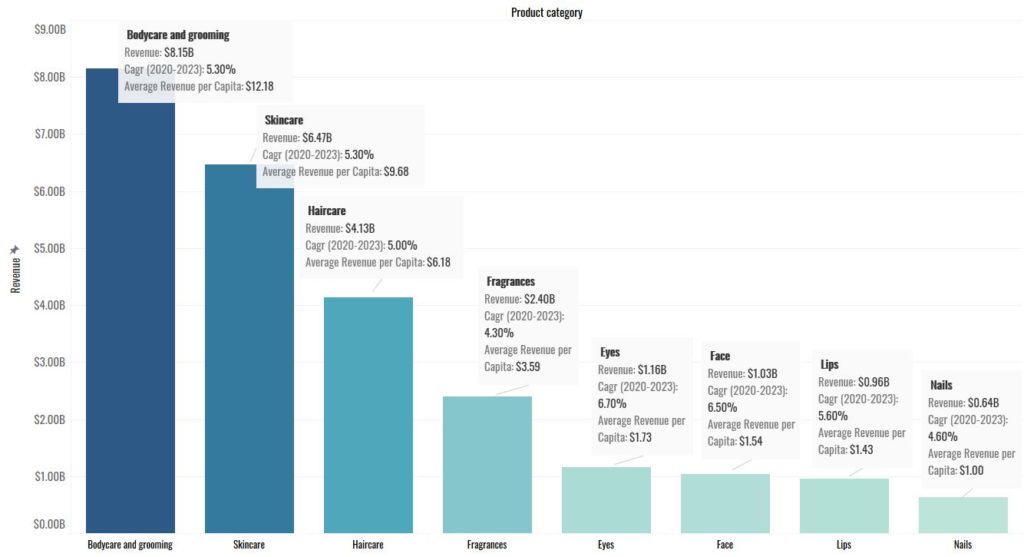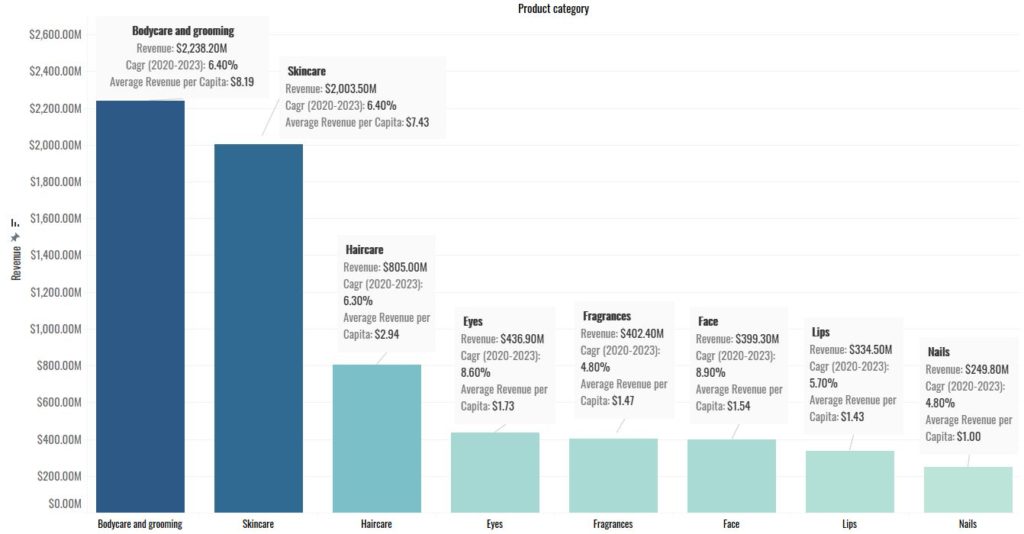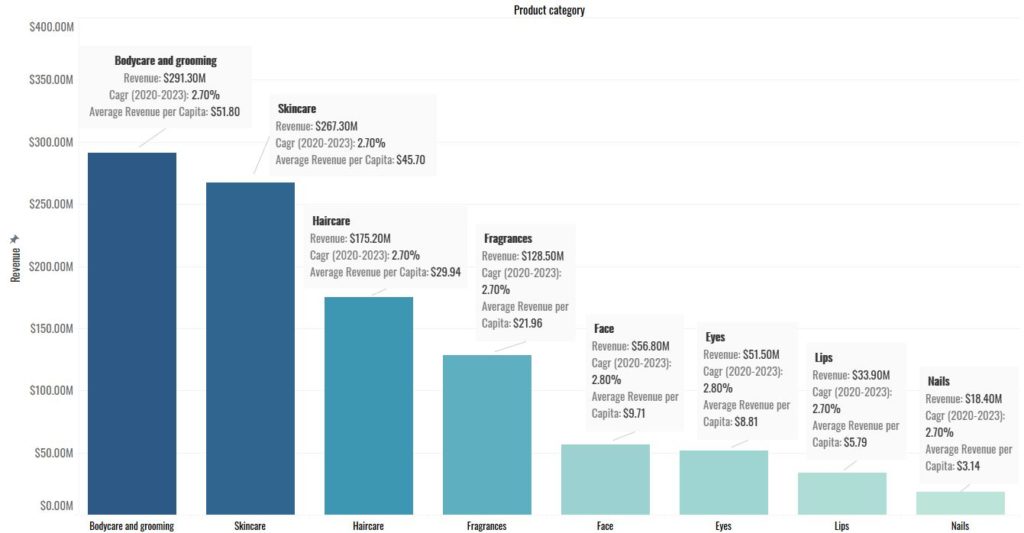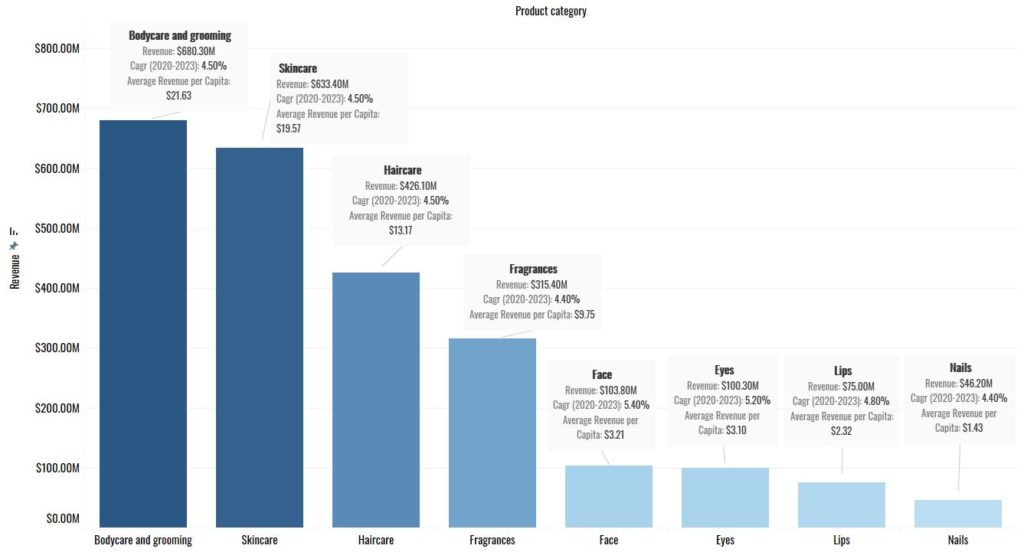Source: Statista
In Southeast Asia revenue in the Beauty and Cosmetics segment amounts to US$25.449billion in 2020. The market is expected to grow annually by 5.3% (CAGR 2020-2023). The average revenue per person in the segment amounts to US$38.6. Where 74% of sales contribute to mass-marketed cosmetics and 26% on luxury items. In which only 13% attributes to online sales. Southeast Asia has seen to be one of the major emerging markets due to its increasingly urban population and beauty trend from its neighboring regions, especially the East Asian market.

Source: Statista
The beauty and cosmetic market are divided into 3 major segments that are makeup, personal care, and fragrances. Where makeup consists of face, lips, nails, and eyes, and personal care consists of skincare, haircare, and body care. The highest revenue is from the personal care segment that is more than US$18.75billion. Whereas the makeup and cosmetics annual revenue account to US3.784billion and fragrance market at 2.397billion in Southeast Asia. With an emerging natural cosmetic market of US$515.9m. Southeast Asia has also seen the highest market share of 61.6% of Halal cosmetics globally.
Indonesia
Revenue in the Beauty and Cosmetics segment amounts to US$7.095b in 2020. The market is expected to grow annually by 6.6% (CAGR 2020-2023).In relation to total population figures, per person revenues of US$25.94 are generated in 2020.
Where 78% of sales are attributable to Non-Luxury goods that are mass-marketed products and 22% to luxury goods. This is due to a very low urban population despite steady growth that in 2020 has gone to 56%.
Due to a huge boom in the e-commerce sector and adoption of the beauty and cosmetic industry currently, 11% of the total sales come from the online medium whereas 89% comes from the direct and retail market.

Source: Statista
Body care and skincare have been the biggest source of revenue of more than 2 million dollars each. Indonesia is also named as Asia’s quickest-growing beauty market for beauty in terms of compound annual growth rate. Despite various promotional and marketing efforts by domestic brands in years, global brands, be it locally manufactured or imported, still dominate cosmetic sales in Indonesia.
Singapore
Singapore’s beauty and personal care revenue has reached US$1.04 billion in 2020 and the market is expected to grow annually by 2.8%. With the highest average revenue per capita of around $177.81
Especially revenue in the cosmetics segment amounts to US$177.9m in 2020. The market is expected to grow annually by 2.8% (CAGR 2020-2023). In relation to total population figures, per person revenues of US$30.41 are generated in 2020.
Where 71% of sales are attributable to Non-Luxury goods that are mass-marketed products and 29% to luxury goods. They have the highest number of urban population that in 2020 is 100%.
Due to a huge boom in the e-commerce sector and adoption of the beauty and cosmetic industry currently, 15% of the total sales come from the online medium whereas 85% comes from the direct and retail market.

Source: Statista
The market is characterized by premiumization, with cosmetics boasting high-value ingredients and polished packaging and marketing, particularly in color cosmetics, skincare, and fragrance. To stay and lead the competition of the market, brands are heavily investing in advertising, promotions, marketing, market research & development. Most of the firms are manufacturing their products in low-cost countries because Singapore’s manufacturing cost is too high.
Singapore is one of the preferred destinations for global cosmetic players in the Southeast Asian region. Rising concern and awareness about the beauty and personal care issues are among the main driving forces behind Singapore’s cosmetic growth spurt. Further, rising per capita disposable income for women is also accelerating the cosmetic sales in Singapore.
Malaysia
Beauty and personal care revenue have reached US$2.421 billion in 2020 and the market is expected to grow annually by 5%. With the average revenue per capita of around $74.81
Revenue in the Cosmetics segment amounts to US$366.2m in 2020. The market is expected to grow annually by 5.0% (CAGR 2020-2023). In relation to total population figures, per person revenues of US$11.32 are generated in 2020.
Where 74% of sales are attributable to Non-Luxury goods that are mass-marketed products and 26% to luxury goods. There has been a steady growth in the urban population that in 2020 has gone to 76%.
Due to a huge boom in the e-commerce sector and adoption of the beauty and cosmetic industry currently, 11% of the total sales come from the online medium whereas 89% comes from the direct and retail market.

Source: Statista
The beauty and health market in Malaysia is growing fast. Consumer expenditure rates on cosmetics and toiletries increased during the last few years. Malaysian consumers tend to obtain beauty products from top name brands that are marketing specifically in terms of enhancing their youthful appearance. with an increase in sales of halal products and known as the halal hub.
Philippines
Beauty and personal care revenue have reached US$5.638 billion in 2020 and the market is expected to grow annually by 3.4%. With the average revenue per capita of around $51.45
Revenue in the Cosmetics segment amounts to US$763.4m in 2020. The market is expected to grow annually by 3.8% (CAGR 2020-2023). In relation to total population figures, per person revenues of US$6.97 are generated in 2020.
Where 73% of sales are attributable to Non-Luxury goods that are mass-marketed products and 27% to luxury goods. There has been a steady growth in the urban population that in 2020 has gone to 47%.
The Philippines market is a retail dominant market and the online market is almost negligible when it comes to beauty and cosmetic products. It is the 2nd highest cosmetic market in southeast Asia yet the awareness of online is very less.
Thailand
Beauty and personal care revenue have reached US$4.023 billion in 2020 and the market is expected to grow annually by 6.2%. With the average revenue per capita of around $57.63
Revenue in the Cosmetics segment amounts to US$763.4m in 2020. The market is expected to grow annually by 3.8% (CAGR 2020-2023). In relation to total population figures, per person revenues of US$6.97 are generated in 2020.
Where 69% of sales are attributable to Non-Luxury goods that are mass-marketed products and 31% to luxury goods. There has been a steady growth in the urban population that in 2020 has gone to 50%.
The market is a retail dominant market and the online market is almost very less with 8% when it comes to beauty and cosmetic products.
Thailand offers not only a large consumer market for beauty products – accounting for a third of the market for Korean cosmetics. Thailand is increasingly building up it’s standing as a manufacturing and export base for beauty products in the Asean region, thanks to an abundance of raw materials, the country’s strategic location, professional expertise, and high standards, an industry figure says.
Vietnam
Beauty and personal care revenue have reached US$2.207 billion in 2020 and the market is expected to grow annually by 5.9%. With the average revenue per capita of around $22.68
Revenue in the Cosmetics segment amounts to US$492.9m in 2020. The market is expected to grow annually by 6.3% (CAGR 2020-2023). In relation to total population figures, per person revenues of US$5.6 are generated in 2020.
Where 78% of sales are attributable to Non-Luxury goods that are mass-marketed products and 22% to luxury goods. There has been a steady growth in the urban population that in 2020 has gone to 36.6%.
There has been a constant growth in the online market in the beauty and cosmetic industry currently, 9% of the total sales come from the online medium whereas 91% comes from the direct and retail market.
Rapid economic growth and higher living standards are shaping changes in Vietnamese lifestyles and needs. Urbanites now spend not only on basic needs but also wants and their desires. Besides being able to afford advanced beauty products, Vietnamese women are not hesitant about paying more for premium products that are capable of bringing about significant skin improvements.
Myanmar
Beauty and personal care revenue have reached US$1.886 billion in 2020 and the market is expected to grow annually by 7.5%. With the average revenue per capita of around $34.66
Revenue in the Cosmetics segment amounts to US$228.8m in 2020. The market is expected to grow annually by 7.7% (CAGR 2020-2023). In relation to total population figures, per person revenues of US$4.2 are generated in 2020.
Where 65% of sales are attributable to Non-Luxury goods that are mass-marketed products and 35% to luxury goods. There has been a steady growth in the urban population that in 2020 has gone to 30.9%.
The Myanmar market is a retail dominant market and the online market is almost negligible when it comes to beauty and cosmetic products. Almost 99% of all the sales are done by the direct market
Myanmar’s cosmetics market is expected to grow significantly in the coming years. It boasts one of Southeast Asia’s largest populations (53 million people) and a growing middle class. Growing middle class and increasing consumer sophistication bolstered sales of non-essential products, such as beauty and personal care, tissue and hygiene, and home care products.
Cambodia
Beauty and personal care revenue have reached US$712 million in 2020 and the market is expected to grow annually by 3%. With the average revenue per capita of around $42.59
Revenue in the Cosmetics segment amounts to US$89.4m in 2020. The market is expected to grow annually by 3.2% (CAGR 2020-2023). In relation to total population figures, per person revenues of US$5.35are generated in 2020.
Where 69% of sales are attributable to Non-Luxury goods that are mass-marketed products and 31% to luxury goods. There has been a steady growth in the urban population that in 2020 has gone to 23.8%.
The beauty and cosmetic market is a retail dominant market and the online market is almost negligible when it comes to beauty and cosmetic products. Almost 98% of all the sales are done by the direct market
Laos
Beauty and personal care revenue have reached US$339 million in 2020 and the market is expected to grow annually by 2.6%. With the average revenue per capita of around $46.6
Revenue in the Cosmetics segment amounts to US$44.3m in 2020. The market is expected to grow annually by 2.8% (CAGR 2020-2023). In relation to total population figures, per person revenues of US$6.08 are generated in 2020.
Where 71% of sales are attributable to Non-Luxury goods that are mass-marketed products and 29% to luxury goods. There has been a steady growth in the urban population that in 2020 has gone to 35.6%.
The Beauty and cosmetic market is a retail dominant market and the online market is almost negligible when it comes to beauty and cosmetic products. Almost 99% of all the sales are done by the direct market
Timur-Leste
Beauty and personal care revenue have reached US$53 million in 2020 and the market is expected to grow annually by 6.7%. With the average revenue per capita of around $40.1
Revenue in the Cosmetics segment amounts to US$6.6m in 2020. The market is expected to grow annually by 6.9% (CAGR 2020-2023). In relation to total population figures, per person revenues of US$4.97 are generated in 2020.
Where 72% of sales are attributable to Non-Luxury goods that are mass-marketed products and 28% to luxury goods. There has been a steady growth in the urban population that in 2020 has gone to 30.9%.
The Beauty and cosmetic market is a retail dominant market and the online market is almost negligible when it comes to beauty and cosmetic products. Almost 99% of all the sales are done by the direct market
Brunei Darussalam
Beauty and personal care revenue have reached US$35 million in 2020 and the market is expected to grow annually by 3%. With the average revenue per capita of around $79.73
Revenue in the Cosmetics segment amounts to US$5.3m in 2020. The market is expected to grow annually by 3.2% (CAGR 2020-2023). In relation to total population figures, per person revenues of US$12.15 are generated in 2020.
Where 72% of sales are attributable to Non-Luxury goods that are mass-marketed products and 28% to luxury goods. There has been a steady growth in the urban population that in 2020 has gone to 35.6%.
There has been a constant growth in the online market in the beauty and cosmetic industry currently, 9% of the total sales come from the online medium whereas 91% comes from the direct and retail market.